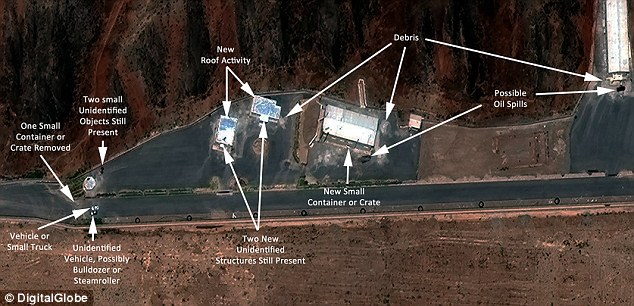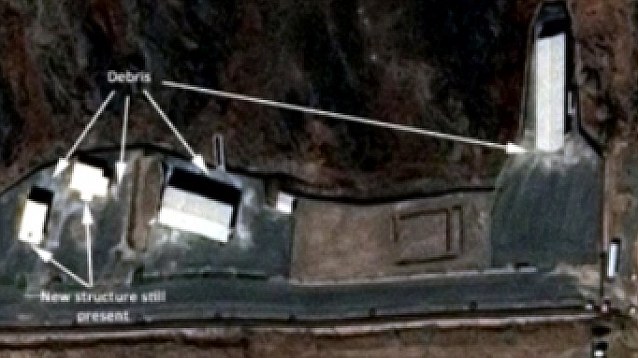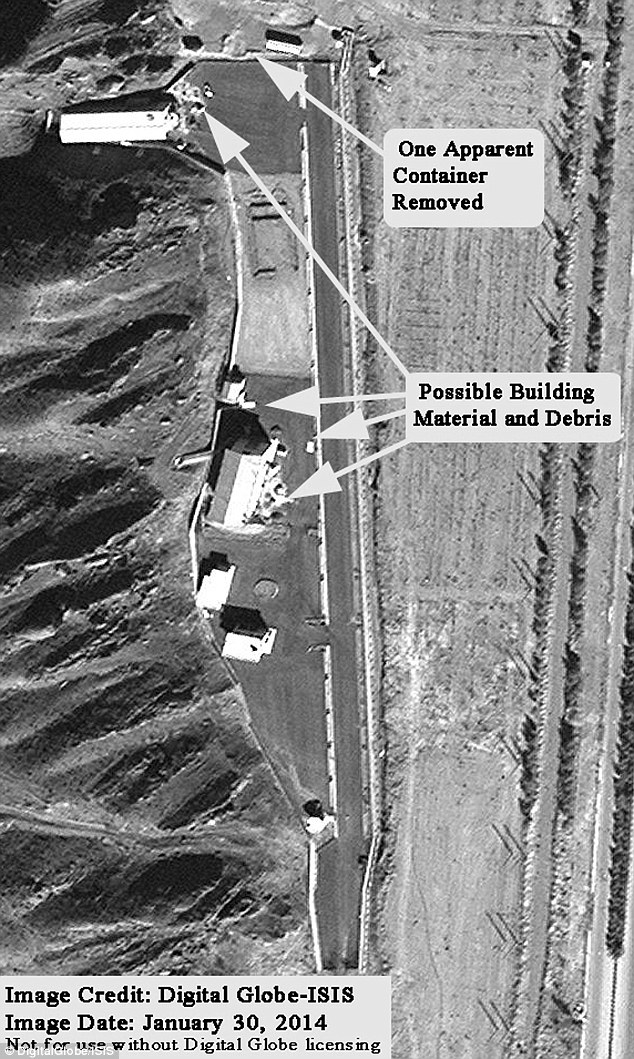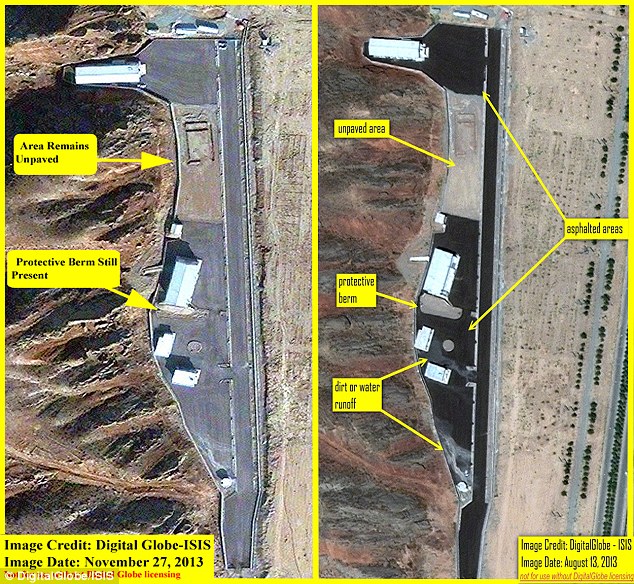BLACKEAGLE
SENIOR MEMBER
Do aerial images show Iran's last-ditch efforts to hide nuclear weapons? Think tank claims 'incriminating evidence' after sanctions are lifted by Obama
Published: 13:11 GMT, 7 August 2015 | Updated: 20:08 GMT, 7 August 2015
Aerial photos of a nuclear site in Iran appear to show 'a last-ditch effort' to hide 'incriminating evidence' before the inspections it agreed to in last month's international deal.
The photos, from a respected Washington think tank, show 'renewed activity' at Parchin, a military site in Iran that has previously been linked to explosives work with nuclear weapons.
A report from the Institute for Science and International Security (ISIS), reveals movement that started after the Joint Comprehensive Plan of Action (JCPOA) to end international sanctions on Iran.
Scroll down for video

+5
The aerial photos released by a Washington think tank purportedly show new activity at Parchin, including (from left) 'one small container removed'; 'unidentified vehicle, possibly bulldozer or steamroller', 'new roof activity', 'two new unidentified structures', 'debris' and 'possible oil spills'
U.S Official: Iran won't be able to conceal nuclear activity

As part of the deal, Iran agreed to host inspectors from the International Atomic Energy Agency (IAEA) at sites such as Parchin, where the country is suspected of developing nuclear weapons.
The report by the Institute for Science and International Security says: 'Although it is difficult to fathom Iran's motivations for its recent actions at Parchin, this renewed activity may be a last-ditch effort to try to ensure that no incriminating evidence will be found.'
The pictures show new activity on the roofs of two buildings, as well as oil spills from vehicles and the presence of two large vehicles - one of which 'could' be a bulldozer or steamroller.
The report says the evidence 'raises concerns' that Iran is trying to conduct 'further sanitization efforts' which make a mockery of the military inspections.
The news comes after the controversial deal signed by the five members of the UN Security Council and Germany, known as the 5+1, to lift sanctions that have been in place for decades.
It includes clauses that state Iran must allow in weapons inspectors, although the some of the details of that agreement have remained secret.
In Tehran, the foreign ministry called the latest report 'baseless and ridiculous', saying any construction at the site was linked to road repairs.
But the assertion was challenged by White House spokesman Josh Earnest, who said: 'For more than a decade, the Iranians had gone to great lengths to try to cover it up.
'We're not particularly concerned that, over the course of the next couple of weeks, that they're going to succeed in covering up something that they haven't been able to cover up over the last decade.'

As part of the deal, Iran agreed to host inspectors from the International Atomic Energy Agency at sites such as Parchin (pictured in a January 2014 photo) where it is suspected the country is developing nuclear weapons

Parchin, an Iranian military complex, has been regularly monitored from the air by the international community. These two aerial photos were taken in November and August 2013
Last week it emerged that Iran wanted to take the soil samples at alleged nuclear sites, instead of the UN, according to US Senators and high-ranking members of the Obama administration.
This may yet be agreed but sources say a final agreement on how tests will be conducted has not yet been reached.
President Obama had struggled to get the JCPOA through Congress, as many politicians felt that Iran could not be trusted.
However, Obama implored them to pass the agreement, saying: 'The bottom line is, if Iran cheats, we can catch them, and we will.'
Last week Iranian president Hassan Rouhini claimed his country had achieved its main goals in the landmark nuclear deal.
In a national address late Sunday, he said the accord recognized Iran's right to enrich uranium.
Access to Parchin would follow years of refusal by Iran, which denies any interest in - or work on - nuclear arms.
Based on US, Israeli and other intelligence and its own research, the IAEA suspects that the Islamic Republic may have experimented with high-explosive detonators for nuclear arms.
Tehran says its program is entirely peaceful, but the U.S. and most other nations believe it has been aimed at acquiring nuclear weapons.
Do photos show Iran hiding nuclear weapons evidence at Parchin military complex? | Daily Mail Online
- Aerial shots reportedly show activity at Parchin military complex, which has been previously linked to nuclear testing
- A Washington watchdog says pictures reveal attempts to 'sanitize' the site
- The activity started after the July 14 agreement between Iran and the U.S., Britain, France, Russia, China, and Germany
- The six world powers agreed to lift economic sanctions if Iran allowed inspections of its nuclear program and didn't build any nuclear weapons
Published: 13:11 GMT, 7 August 2015 | Updated: 20:08 GMT, 7 August 2015
Aerial photos of a nuclear site in Iran appear to show 'a last-ditch effort' to hide 'incriminating evidence' before the inspections it agreed to in last month's international deal.
The photos, from a respected Washington think tank, show 'renewed activity' at Parchin, a military site in Iran that has previously been linked to explosives work with nuclear weapons.
A report from the Institute for Science and International Security (ISIS), reveals movement that started after the Joint Comprehensive Plan of Action (JCPOA) to end international sanctions on Iran.
Scroll down for video

+5
The aerial photos released by a Washington think tank purportedly show new activity at Parchin, including (from left) 'one small container removed'; 'unidentified vehicle, possibly bulldozer or steamroller', 'new roof activity', 'two new unidentified structures', 'debris' and 'possible oil spills'
U.S Official: Iran won't be able to conceal nuclear activity

As part of the deal, Iran agreed to host inspectors from the International Atomic Energy Agency (IAEA) at sites such as Parchin, where the country is suspected of developing nuclear weapons.
The report by the Institute for Science and International Security says: 'Although it is difficult to fathom Iran's motivations for its recent actions at Parchin, this renewed activity may be a last-ditch effort to try to ensure that no incriminating evidence will be found.'
The pictures show new activity on the roofs of two buildings, as well as oil spills from vehicles and the presence of two large vehicles - one of which 'could' be a bulldozer or steamroller.
The report says the evidence 'raises concerns' that Iran is trying to conduct 'further sanitization efforts' which make a mockery of the military inspections.
The news comes after the controversial deal signed by the five members of the UN Security Council and Germany, known as the 5+1, to lift sanctions that have been in place for decades.
It includes clauses that state Iran must allow in weapons inspectors, although the some of the details of that agreement have remained secret.
In Tehran, the foreign ministry called the latest report 'baseless and ridiculous', saying any construction at the site was linked to road repairs.
But the assertion was challenged by White House spokesman Josh Earnest, who said: 'For more than a decade, the Iranians had gone to great lengths to try to cover it up.
'We're not particularly concerned that, over the course of the next couple of weeks, that they're going to succeed in covering up something that they haven't been able to cover up over the last decade.'

As part of the deal, Iran agreed to host inspectors from the International Atomic Energy Agency at sites such as Parchin (pictured in a January 2014 photo) where it is suspected the country is developing nuclear weapons

Parchin, an Iranian military complex, has been regularly monitored from the air by the international community. These two aerial photos were taken in November and August 2013
Last week it emerged that Iran wanted to take the soil samples at alleged nuclear sites, instead of the UN, according to US Senators and high-ranking members of the Obama administration.
This may yet be agreed but sources say a final agreement on how tests will be conducted has not yet been reached.
President Obama had struggled to get the JCPOA through Congress, as many politicians felt that Iran could not be trusted.
However, Obama implored them to pass the agreement, saying: 'The bottom line is, if Iran cheats, we can catch them, and we will.'
Last week Iranian president Hassan Rouhini claimed his country had achieved its main goals in the landmark nuclear deal.
In a national address late Sunday, he said the accord recognized Iran's right to enrich uranium.
Access to Parchin would follow years of refusal by Iran, which denies any interest in - or work on - nuclear arms.
Based on US, Israeli and other intelligence and its own research, the IAEA suspects that the Islamic Republic may have experimented with high-explosive detonators for nuclear arms.
Tehran says its program is entirely peaceful, but the U.S. and most other nations believe it has been aimed at acquiring nuclear weapons.
Do photos show Iran hiding nuclear weapons evidence at Parchin military complex? | Daily Mail Online
